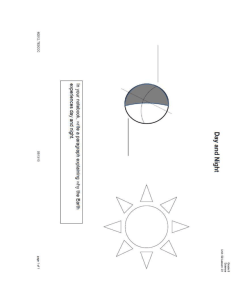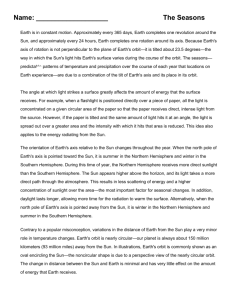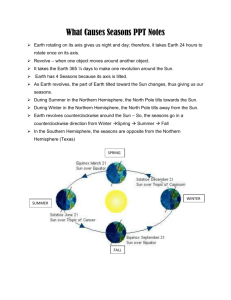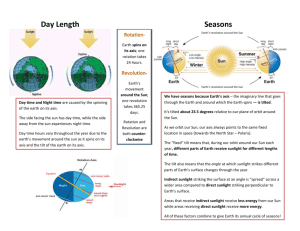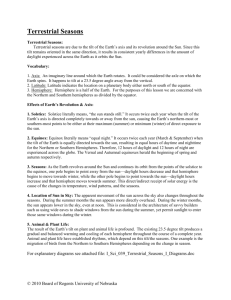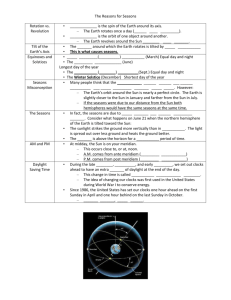The Year and Seasons - Starry Night Education
advertisement
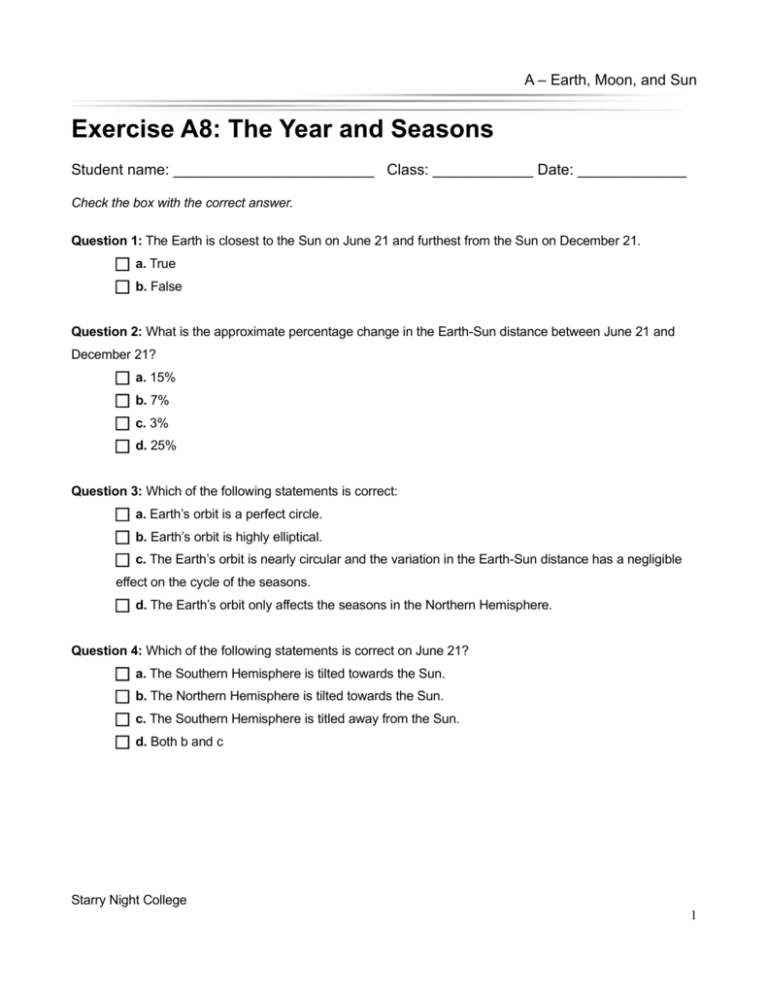
A – Earth, Moon, and Sun Exercise A8: The Year and Seasons Student name: ________________________ Class: ____________ Date: _____________ Check the box with the correct answer. Question 1: The Earth is closest to the Sun on June 21 and furthest from the Sun on December 21. a. True b. False Question 2: What is the approximate percentage change in the Earth-Sun distance between June 21 and December 21? a. 15% b. 7% c. 3% d. 25% Question 3: Which of the following statements is correct: a. Earth’s orbit is a perfect circle. b. Earth’s orbit is highly elliptical. c. The Earth’s orbit is nearly circular and the variation in the Earth-Sun distance has a negligible effect on the cycle of the seasons. d. The Earth’s orbit only affects the seasons in the Northern Hemisphere. Question 4: Which of the following statements is correct on June 21? a. The Southern Hemisphere is tilted towards the Sun. b. The Northern Hemisphere is tilted towards the Sun. c. The Southern Hemisphere is titled away from the Sun. d. Both b and c Starry Night College 1 A – Earth, Moon, and Sun Exercise A8: The Year and Seasons Question 5: Which of the following statements is correct on December 21? a. The Northern Hemisphere is tilted away from the Sun. b. The Southern Hemisphere is tilted away from the Sun. c. The Southern Hemisphere is tilted towards the Sun. d. Both a and c Question 6: As the Earth orbits the Sun; observe the tilt and direction of the Earth's rotation axis. Which of the following statements is true? a. The Earth's tilt remains the same and the rotation axis maintains the same orientation. b. The Earth's tilt remains the same but the rotation axis changes orientation. c. Both the angle and orientation of Earth's rotation axis change. d. Earth's degree of tilt changes but the orientation of the axis remains the same. Question 7: Based on your observations, as the Earth revolves around the Sun: a. The hemisphere tilted towards the Sun experiences summer and the hemisphere tilted away from the Sun experiences winter. b. The hemisphere tilted away from the Sun experiences summer and the hemisphere tilted towards the Sun experiences winter. c. The tilt and direction of the Earth's rotation axis remain constant. d. Both a and c Question 8: How many hours of daylight does New York City receive (time between sunrise and sunset) and how high does the Sun get in the sky? Hint: The Sun is highest in the sky when it crosses the meridian. a. 15 hours of daylight and the Sun reaches an altitude of 72 degrees. b. 8 hours of daylight and the Sun reaches an altitude of 27 degrees. c. 18 hours of daylight and the Sun reaches an altitude of 90 degrees. d. 12 hours of daylight and the Sun reaches an altitude of 49 degrees. Starry Night College 2 A – Earth, Moon, and Sun Exercise A8: The Year and Seasons Question 9: How many hours of daylight does New York City receive and how high does the Sun get in the sky? a. 18 hours of daylight and the Sun reaches an altitude of 90 degrees. b. 12 hours of daylight and the Sun reaches an altitude of 49 degrees. c. 15 hours of daylight and the Sun reaches an altitude of 72 degrees. d. 9.5 hours of daylight and the Sun reaches an altitude of 26 degrees. Question 10: Which of the following statements explains why we experience the annual cycle of seasons? a. Earth’s orbit is slightly elliptical. b. The tilt of Earth’s rotational axis changes the flux of sunlight hitting Earth’s surface. c. The tilt of Earth’s rotational axis changes the number of hours of daylight over the seasons. d. Both b and c combine to produce Earth’s seasons. Question 11: Which of the following statements is correct? a. Daytime and nighttime hours are equal. b. The Sun is found on the celestial equator as seen from Earth. c. The Northern and Southern Hemispheres receive equal amounts of sunlight. d. All of the above. Question 12: Does Mars experience seasons? a. Mars has seasons because its orbit is similar to the Earth’s orbit. b. Mars does not have seasons because it is too far from the Sun. c. Mars has seasons because its rotation axis is tilted with respect to the ecliptic. d. Mars does not have seasons because its orbit is not as circular as Earth’s orbit. Starry Night College 3

